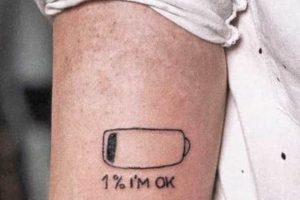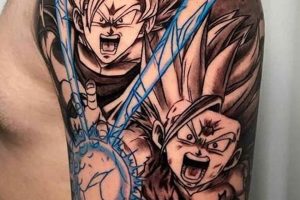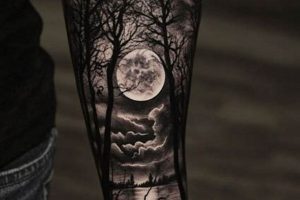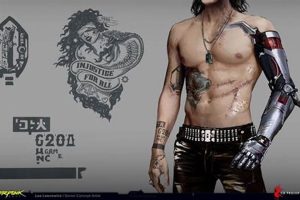Tattoos inspired by Norse mythology and Viking culture encompass a wide range of symbolic imagery, from gods and goddesses like Odin, Thor, and Freya, to mythical creatures like Valkyries, dragons, and ravens. Runes, ancient Norse symbols representing letters and concepts, also serve as common design elements. These designs can be rendered in various styles, including minimalist linework, intricate knotwork, and realistic portrayals.
The enduring appeal of this imagery stems from a rich history and complex symbolism. These designs can represent strength, courage, wisdom, destiny, and connection to heritage. The choice of specific symbols often reflects personal values or beliefs, making each tattoo a deeply meaningful expression. The historical significance of Viking art and mythology adds another layer of depth and intrigue to these designs.
Exploration of specific deities, creatures, and symbols, along with discussions of stylistic choices and placement considerations, will provide a comprehensive understanding of the potential within this rich artistic tradition.
1. Symbolism
Symbolism lies at the heart of Norse-inspired tattoos. The choice of a particular symbol imbues the tattoo with specific meaning, connecting the wearer to ancient myths, legends, and cultural values. Understanding the rich symbolism behind each element is crucial for creating a meaningful and resonant design.
- Gods and Goddesses
Depictions of deities like Odin (wisdom, magic), Thor (strength, protection), and Freya (love, beauty) represent the wearer’s admiration for these figures and the qualities they embody. Choosing a specific deity often reflects the individual’s personal values or desired attributes.
- Mythical Creatures
Creatures such as ravens (messengers, wisdom), wolves (loyalty, guardianship), and dragons (power, chaos) add another layer of symbolism. These figures often represent specific myths or legends, and their inclusion can signify a connection to these narratives.
- Runes
Each rune possesses a unique meaning, ranging from concepts like strength and protection to more abstract ideas like journey and destiny. Incorporating runes allows for personalized messages and intentions to be woven into the design.
- Objects and Symbols
Items like Mjolnir (Thor’s hammer), the Valknut (symbol of Odin and fallen warriors), and the Yggdrasil (the world tree) carry powerful symbolic weight. These objects represent core Norse beliefs and values, adding depth and complexity to the tattoo’s meaning.
Careful selection and combination of these symbolic elements allows for the creation of a deeply personal and meaningful tattoo that resonates with the wearer’s individual beliefs and connection to Norse culture and mythology. The symbolic depth inherent in these designs elevates them beyond mere aesthetics, transforming them into powerful statements of identity and heritage.
2. Design Style
The visual impact of a Norse-inspired tattoo hinges significantly on the chosen design style. This stylistic choice influences not only the aesthetic appeal but also the interpretation of the chosen symbolism. Understanding the various design styles available allows for a more informed decision, ensuring the final result aligns with individual preferences and desired symbolism.
- Traditional/Viking Age Style
Inspired by historical artifacts and art from the Viking Age, this style often features intricate knotwork, interlacing patterns, and zoomorphic designs. These designs often prioritize historical accuracy and traditional aesthetics, conveying a sense of authenticity and connection to the past.
- Realistic/Illustrative
This style focuses on detailed and lifelike depictions of Norse figures and creatures, often incorporating shading, texture, and perspective to create a sense of depth and realism. Illustrative tattoos can capture the dramatic narratives of Norse mythology with striking visuals.
- Minimalist/Geometric
Characterized by clean lines, simple shapes, and negative space, this style offers a modern interpretation of Norse symbolism. Minimalist designs often focus on the core essence of a symbol, conveying its meaning with elegant simplicity.
- Dotwork/Blackwork
Utilizing intricate dot patterns and solid black ink, these styles create bold and visually striking designs. Dotwork and blackwork can be used to create intricate textures and patterns, lending a unique and powerful aesthetic to Norse imagery.
Selecting the appropriate design style is essential for effectively communicating the desired message and creating a visually compelling tattoo. The interplay between chosen symbolism and design style significantly impacts the overall aesthetic and the tattoo’s perceived meaning. By carefully considering the various stylistic options, individuals can ensure their Norse-inspired tattoo becomes a powerful and aesthetically pleasing representation of their chosen symbolism.
3. Placement
Placement plays a crucial role in the overall impact and effectiveness of Norse-inspired tattoos. The chosen location on the body influences not only the visual presentation of the design but also its perceived meaning and relationship to the wearer’s physique. Consideration of body contours, muscle movement, and the design’s size and shape are essential for achieving a harmonious and aesthetically pleasing result.
Larger, more complex designs featuring scenes from Norse mythology or depictions of sprawling figures like Yggdrasil, the world tree, often benefit from placement on broader areas like the back, chest, or thighs. These locations offer ample space for intricate details and allow the narrative elements of the design to unfold fully. Smaller, more symbolic designs, such as individual runes or smaller depictions of animals like ravens or wolves, can be effectively placed on the forearm, wrist, or behind the ear, where their symbolic meaning can be readily displayed. Circular designs often lend themselves well to placement on the shoulders or upper arms, mirroring the natural curves of the body.
Strategic placement can further enhance the symbolism of the tattoo. For instance, a Vegvisir, a Norse compass intended for guidance, might be placed on the wrist or forearm, symbolizing its role in directing one’s path. Similarly, a depiction of a valkyrie, a chooser of the slain, might be placed near the heart or ribs, signifying protection and courage. Understanding the relationship between placement and symbolism adds another layer of depth and meaning to the tattoo, transforming it into a more powerful and personal statement. Careful consideration of placement ensures the design integrates seamlessly with the body, maximizing its visual impact and reinforcing its intended meaning.
4. Artist Selection
Realizing the full potential of Norse-inspired tattoos requires careful consideration of artist selection. A skilled artist specializing in this style possesses the technical expertise and cultural understanding necessary to execute the intricate designs and complex symbolism accurately and respectfully. Choosing the right artist is paramount to ensuring the final result is a powerful and aesthetically pleasing representation of the chosen Norse imagery.
- Portfolio Examination
A thorough review of an artist’s portfolio is essential. Look for examples of previous Norse-inspired tattoos, paying close attention to the accuracy of the depicted symbolism, the precision of linework, and the overall aesthetic quality. A strong portfolio demonstrating experience with similar designs indicates the artist’s familiarity with the nuances of Norse iconography.
- Understanding of Norse Symbolism
Beyond technical skill, a deep understanding of Norse mythology and symbolism is crucial. An artist well-versed in the meaning behind various symbols and figures can offer valuable insights into design choices, ensuring the tattoo accurately reflects the intended message. This knowledge prevents misinterpretations and ensures the chosen symbols align with the wearer’s desired meaning.
- Style Compatibility
Different artists specialize in various tattoo styles. Matching the artist’s style to the desired aesthetic is vital. Whether seeking a traditional Viking Age style, a realistic depiction, or a more modern interpretation, selecting an artist whose style aligns with the envisioned design ensures a cohesive and aesthetically pleasing result.
- Consultation and Communication
Open communication with the chosen artist is paramount. A thorough consultation allows for a collaborative approach to the design process. Discussing ideas, exploring symbolism, and addressing any concerns ensures the final design accurately reflects the individual’s vision and resonates with their personal connection to Norse culture.
The selection of a skilled and knowledgeable artist is a critical investment in the quality and longevity of a Norse-inspired tattoo. A collaborative approach, combined with the artist’s expertise in both technical execution and cultural understanding, ensures the final result is a meaningful and visually stunning piece of art that honors the rich traditions of Norse mythology and artistry. This careful selection process transforms the tattoo into a powerful expression of personal identity and cultural appreciation.
Tips for Norse Tattoo Designs
Careful planning ensures a meaningful and aesthetically pleasing Norse tattoo. Consider these tips for successful design choices.
Tip 1: Research Thoroughly: Deepen understanding of Norse symbols and mythology. Accurate interpretation prevents unintended misrepresentations of chosen designs.
Tip 2: Prioritize Meaning: Select symbols resonating with personal values and beliefs. This imbues the tattoo with lasting significance beyond mere aesthetics.
Tip 3: Consider Placement Carefully: Body contours and design size impact the tattoo’s visual impact. Placement should complement both the design and the body’s natural lines.
Tip 4: Choose a Skilled Artist: Seek an artist experienced in Norse-inspired tattoos. A portfolio showcasing accurate depictions and stylistic proficiency is essential.
Tip 5: Plan for Long-Term Care: Norse tattoos, especially intricate designs, require proper aftercare. Commitment to maintaining the tattoo’s vibrancy ensures long-term visual appeal.
Tip 6: Explore Different Styles: Research various stylistic interpretations of Norse imagery. From traditional to modern, the chosen style should complement the symbolism and personal aesthetic.
Tip 7: Balance Complexity and Clarity: Intricate designs can be visually stunning, but ensure the core symbolism remains clear and recognizable. Avoid excessive detail that might obscure the intended meaning.
Thorough planning and careful consideration of these elements result in a powerful and visually striking tattoo that honors the rich traditions of Norse culture and resonates with personal meaning.
By following these guidelines, individuals can embark on the journey towards a meaningful and aesthetically impactful Norse tattoo that embodies their connection to this rich cultural heritage.
Frequently Asked Questions about Norse Tattoo Ideas
This section addresses common inquiries regarding Norse-inspired tattoos, offering clarity on practical considerations and symbolic interpretations.
Question 1: How does one choose the right Norse symbol for a tattoo?
Symbol selection depends on personal resonance and intended meaning. Thor represents strength and protection, while Odin symbolizes wisdom and magic. Researching the symbolism ensures alignment with personal values.
Question 2: Are there any cultural sensitivities to consider when choosing a Norse tattoo?
Respectful representation of Norse symbols is crucial. Avoid frivolous or disrespectful depictions. Understanding the cultural context prevents misappropriation and honors the traditions.
Question 3: What are the typical costs associated with Norse tattoos?
Cost varies depending on size, complexity, and artist experience. Intricate designs requiring multiple sessions naturally incur higher costs. Consulting with chosen artists provides accurate estimates.
Question 4: How painful are Norse tattoos, particularly in certain locations?
Pain levels differ based on individual pain tolerance and tattoo placement. Areas with thinner skin or closer proximity to bone tend to be more sensitive. Discussing pain management options with the artist is advisable.
Question 5: What is the typical healing time for a Norse tattoo?
Healing typically takes several weeks, depending on size and placement. Following proper aftercare instructions from the artist ensures optimal healing and prevents complications.
Question 6: Can Norse tattoos be modified or covered up later?
Modification or cover-up feasibility depends on the original design’s size, complexity, and ink density. Consulting with a skilled artist experienced in cover-ups provides the best assessment and options.
Careful consideration of these frequently asked questions provides a comprehensive understanding of the practical aspects and cultural considerations associated with Norse-inspired tattoos. Informed decision-making ensures a meaningful and respectful representation of chosen symbolism.
Further exploration of specific design elements and consultations with experienced tattoo artists will aid in the creation of a truly unique and personally resonant piece of body art.
Norse Tattoo Ideas
Exploration of Norse-inspired tattoo designs reveals a rich tapestry of symbolic imagery drawn from a compelling mythology and vibrant cultural heritage. From depictions of powerful deities like Odin and Thor to intricate knotwork patterns and symbolic runes, these designs offer a powerful means of personal expression and cultural connection. Careful consideration of symbolism, design style, placement, and artist selection ensures a meaningful and aesthetically impactful result. Understanding the historical and cultural context of these symbols adds depth and significance to the chosen design, transforming it from mere body art into a powerful statement of personal identity.
The enduring appeal of Norse mythology and Viking artistry continues to inspire individuals seeking meaningful and visually striking tattoos. By embracing the rich symbolism and artistic traditions of this ancient culture, individuals can create lasting tributes to their personal values and connection to a powerful historical narrative. The journey into the world of Norse tattoo design offers a profound opportunity for self-expression and cultural exploration, resulting in a powerful and enduring piece of art that resonates with both personal meaning and historical significance.







